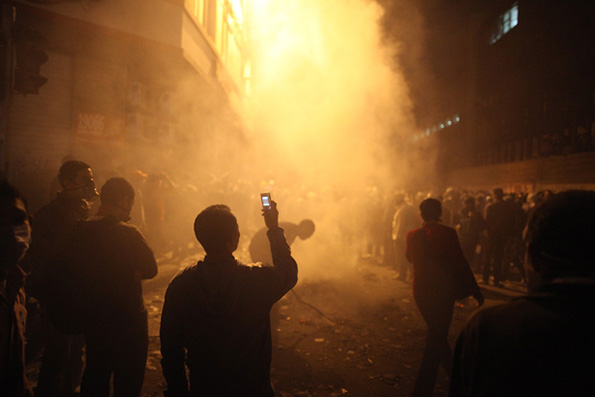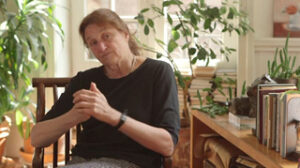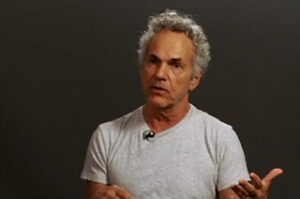Pete Brook is a freelance writer and curator interested in social justice. He writes and edits PrisonPhotography.com, a website that analyzes imagery produced within and about the American prison industrial complex. Brook has lectured internationally, taught art in prisons, volunteered with Books to Prisoners, and served as a University Beyond Bars board member. He has curated multiple shows, including Non Sufficient Funds, Vermillion, Seattle (2011); Cruel and Unusual, Noorderlicht, Groningen, Netherlands (2012); The Depository of Unwanted Photographs, Photoville, New York (2013); Seen but Not Heard, Kulturni centar Beograda, Belgrade, Serbia (2013); and Prison Obscura, Cantor Fitzgerald Gallery, Haverford, Pennsylvania (2014). Prison Photography has been recognized as one of the best photography blogs by LIFE.com, The British Journal of Photography, and The Daily Beast. Brook’s activities have been featured in The New York Times, The British Journal of Photography, Kickstarter, Feature Shoot, and dvafoto. He writes regularly for Raw File, the Wired photography blog. Brook lives in Portland, Oregon.
Overview
The Bearing Witness symposium was held at SFMOMA on March 16, 2014.

Protesters Gather For Tahrir Square Rally, November 23, 2011, Peter Macdiarmid/Getty Images
Given the power and pervasiveness of photography in both art and everyday life, what is the significance of the rapid and fundamental changes that the field is undergoing? How have social media, digital cameras, and amateur photojournalism altered the way photographs capture the everyday, define current events, and steer social and political movements? How have photographers responded to these shifting conditions, as well as to the new ways in which images are understood, shared, and consumed? How have our expectations of photography changed?
This symposium considered these questions and assessed the ways in which photography matters now more than ever. Bearing Witness was convened by Erin O’Toole, associate curator of photography, and Dominic Willsdon, Leanne and George Roberts Curator of Education and Public Programs, SFMOMA.
Director’s Welcome
Excerpted from the Bearing Witness program:
Welcome, and thank you for being part of this day of discussion delving into the critical new role of photography in contemporary society.
Four years ago we gathered major thinkers from across the country to consider the question “Is Photography Over?” Given the rise of new technologies and the expanding and changing definition of the field, we wanted to probe what might be lost and what might be gained.
Today’s symposium poses a new set of pressing questions, precipitated again by the effects of evolving technology and the ubiquity of photographic images but with this radical shift: the explosive rise of social media in the cultural landscape even in the four years since that last gathering.
We are extremely pleased to welcome an eminent group of scholars, commentators, and photographers from across the field to consider how these changing conditions — most vitally, the ease of producing and distributing pictures instantaneously ― profoundly affect the ways photography is used to communicate about the world around us.
I extend my sincere thanks to the Fraenkel Gallery for their generous support of this series of symposia through the Fund for New Studies in Photography. As an institution with a long-standing commitment to collecting and presenting photography in all its forms, SFMOMA strives to promote dialogue about the role and influence of the medium in our lives, and the fund’s support makes this possible today.
Neal Benezra
Director, SFMOMA
Schedule
| Introduction | Erin O’Toole, associate curator of photography, SFMOMA |
| Keynote | Margaret Olin, senior research scholar, Yale University: “Witnessing, Bystanding, Onlooking, Participating” |
| Session 1 |
|
| Session 2 |
|
| Session 3 |
|
Watch
Recorded live on Sunday, March 16, 2014, at Yerba Buena Center for the Arts Theater. Video: Jim Granato.
Recorded live on Sunday, March 16, 2014, at Yerba Buena Center for the Arts Theater. Video: Jim Granato.
Participants
Pete Brook
Mike Krieger
Mike Krieger is the cofounder and head of engineering at Instagram. As technical cofounder, Mike has played a role in building the Instagram mobile apps, scaling the Instagram infrastructure to over 150 million active users, and recruiting the Instagram engineering team. At Stanford, Krieger studied symbolic systems, a mix of computer science, design, and cognitive science.
Benjamin Lowy
Benjamin Lowy is an award-winning photographer based in New York City. He received a BFA from Washington University in St. Louis in 2002 and began his career covering the Iraq War in 2003. Since then he has covered major stories worldwide. In 2004 Lowy attended the World Press Joop Swart Masterclass; he was named in Photo District News’ 30; and his images of Iraq were chosen by PDN as some of the most iconic of the 21st century. Lowy has received awards from World Press Photo, POYi, PDN, Communication Arts, American Photography, and the Society for Publication Design. Lowy has been a finalist for the Oskar Barnak Award and Critical Mass. His work was included in Magenta Flash Forward 2007, as well as the Open Society Institute’s exhibition Moving Walls 16. His work from Iraq, Darfur, and Afghanistan has been collected into several gallery and museum exhibitions, and shown at Tate Modern, SFMOMA, Houston Center for Photography, Invalides, and Les Rencontres d’Arles. His work from Darfur appeared in the SAVE DARFUR media campaign. In 2011 Lowy’s Iraq | Perspectives work was selected by William Eggleston to win the Duke University Center for Documentary Studies/Honickman First Book Prize in Photography. In 2012 Lowy received an award from the Magnum Foundation Emergency Fund to continue his work in Libya. In the same year, he received the International Center of Photography (ICP) Infinity Award for Photojournalism.
Susan Meiselas
Susan Meiselas received her BA from Sarah Lawrence College and her MA in visual education from Harvard University. Her first major photographic essay, Carnival Strippers, was originally published in 1976 and a selection was installed at the Whitney Museum of American Art in June 2000. Meiselas joined Magnum Photos in 1976 and has worked as a freelance photographer since then. She is best known for her coverage of the insurrection in Nicaragua and her documentation of human rights issues in Latin America. She published her second monograph, Nicaragua, in 1981. Meiselas served as an editor of and contributor to the book El Salvador: The Work of Thirty Photographers and edited Chile from Within, featuring work by photographers living under the Pinochet regime. She has co-directed two films, Living at Risk: The Story of a Nicaraguan Family and Pictures from a Revolution, with Richard P. Rogers and Alfred Guzzetti. In 1997 she completed a six-year project curating a 100-year photographic history of Kurdistan, integrating her own work into the book Kurdistan: In the Shadow of History. She developed akaKurdistan, an online site of exchange for collective memory, in 1998. Her monograph Pandora’s Box, which explores a New York S & M club, has been exhibited both at home and abroad. Encounters with the Dani reveals a 60-year history of outsiders’ discovery of and interactions with the Dani, an indigenous people of the highlands of Papua in Indonesia. Meiselas is presently serving as president of the Magnum Foundation.
Margaret Olin
Margaret Olin is a senior research scholar with appointments at Yale Divinity School as well as the Department of Religious Studies, the Program in Judaic Studies, and the Department of the History of Art. From 1986 until her arrival at Yale in 2009 she was a professor at the School of the Art Institute of Chicago in the departments of Art History, Theory and Criticism, and Visual and Critical Studies. She is the author most recently of Touching Photographs (University of Chicago Press, 2012). She is also co-editor, with Robert S. Nelson, of Monuments and Memory, Made and Unmade (University of Chicago Press, 2003) and, with Steven Fine, Vivian B. Mann, and Maya Balakirsky-Katz, co-edits the journal Images: A Journal of Jewish Art and Visual Culture. In 2012 she curated the multi-venue exhibition Shaping Community: Poetics and Politics of the Eruv at Yale University, to which she contributed the photographic installations “Urban Bricolage” and “No Carry Zone.”
Doug Rickard
Doug Rickard studied U.S. history and sociology at the University of California, San Diego, before moving to photography. He has drawn on this background in research for his series A New American Picture, which focuses on places in the United States where unemployment is high and educational opportunities are few. On a virtual road trip, Rickard located these sites remotely using the Street View feature of Google Maps, which has mapped and photographed nearly every street in the country. Scrutinizing the Google Maps pictures, he composed images on his computer screen, which he then photographed using a digital camera. The resulting pictures — digitally manipulated to remove the Google watermark and cropped to a panoramic format — comment on poverty and racial equity in the United States, the bounty of images on the web, and issues of personal privacy.
Kathy Ryan
Kathy Ryan, the longtime director of photography at The New York Times Magazine, has been a pioneer in combining fine art photography and photojournalism in the pages of the magazine. During this time, the magazine has been recognized with numerous photography awards, including National Magazine Awards in 2011 and 2012. Ryan received the Royal Photographic Society’s annual award for Outstanding Service to Photography in 2012. She was honored with a lifetime achievement award from the Griffin Museum of Photography in 2007. Under Ryan’s leadership, the magazine regularly commissions the world’s best photographers, across an array of disciplines. The best of this work can be seen in a book edited by Ryan, titled The New York Times Magazine Photographs, published by Aperture in 2011. A traveling exhibition of photographs from the book, co-curated by Ryan, opened at Les Rencontres d’Arles in 2011, then traveled to Foam in Amsterdam and Palau Robert in Barcelona in 2012. In addition to her magazine work, Ryan also lectures and serves on many photo juries. She serves as a mentor at the School of Visual Arts in New York, and has worked as a thesis advisor there. In June she co-curated the LOOK3 photography festival in Charlottesville, Virginia, and in 2008 she was a co-curator of the inaugural New York Photo Festival. Ryan has also curated exhibitions for the Museum of the City of New York, Foam, and the School of Visual Arts. She regularly posts images celebrating the life and light at The New York Times, in a series called “Office Romance.”
Zoe Strauss
Zoe Strauss is a photographer and installation artist based in Philadelphia. First known for I-95, her annual one-day exhibitions of street photographs under the highway in South Philadelphia, she has had solo exhibitions at the Philadelphia Museum of Art, the International Center of Photography, and the Institute of Contemporary Art, Philadelphia, among others. She has received many awards for her photography, including a Seedling Award from the Leeway Foundation (2002) and a Pew Fellowship (2005), and was a 2007 United States Artists Gund Fellow in the Visual Arts. Her work is held in museum collections nationally and was included in the 2006 Whitney Biennial and 2013 Carnegie International. She is currently a visiting professor at the California Institute of the Arts in Los Angeles.
The Ethics of Seeing


